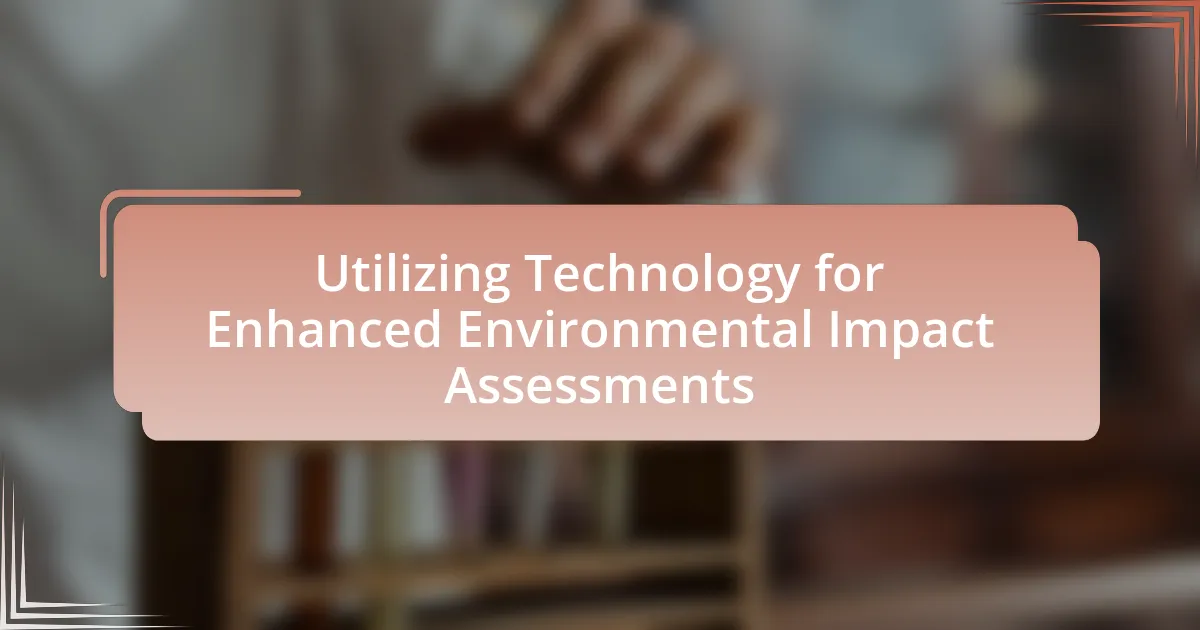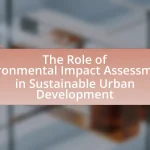Utilizing technology for enhanced environmental impact assessments involves the integration of advanced tools such as Geographic Information Systems (GIS), remote sensing, and modeling software to improve the evaluation of potential environmental effects of proposed projects. These technologies enhance data accuracy, facilitate real-time monitoring, and support comprehensive analysis, leading to better-informed decision-making and regulatory compliance. The article discusses the types of technology commonly used, their integration with traditional methods, the importance of accurate assessments, and the potential consequences of inadequate evaluations. Additionally, it addresses the challenges and limitations of current technologies, as well as best practices for effective implementation and continuous improvement in environmental assessments.
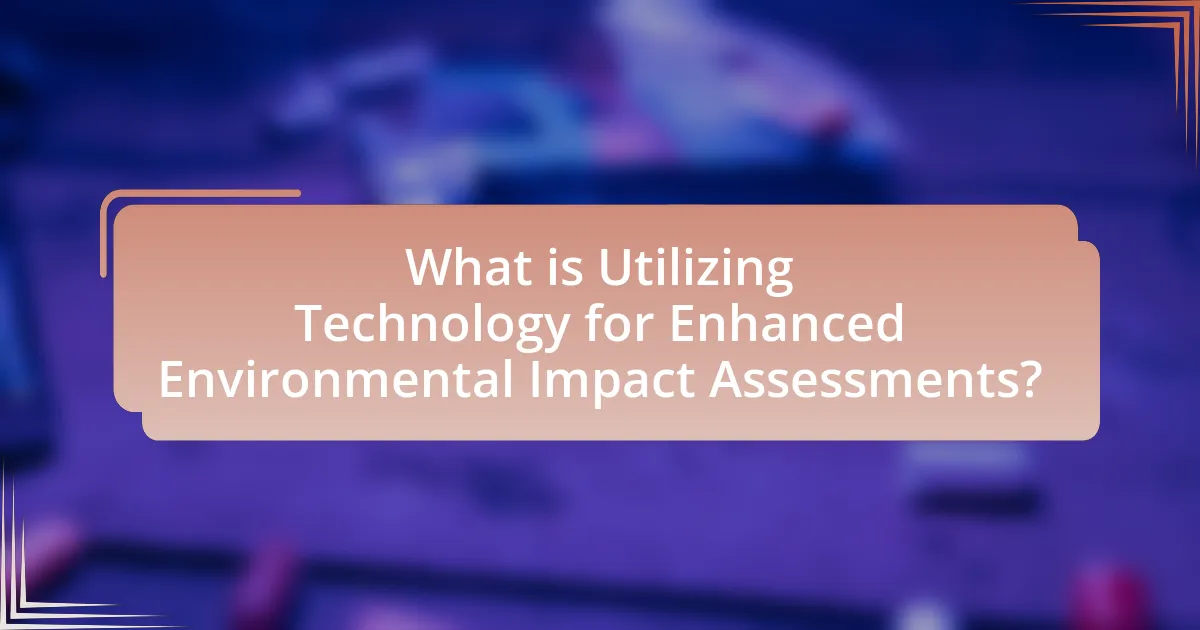
What is Utilizing Technology for Enhanced Environmental Impact Assessments?
Utilizing technology for enhanced environmental impact assessments involves the integration of advanced tools and methodologies to improve the evaluation of potential environmental effects of proposed projects. This includes the use of Geographic Information Systems (GIS) for spatial analysis, remote sensing for data collection, and modeling software to predict environmental outcomes. For instance, GIS can analyze land use patterns and biodiversity impacts, while remote sensing can monitor changes in land cover and ecosystems over time. These technologies enable more accurate, efficient, and comprehensive assessments, leading to better-informed decision-making and regulatory compliance.
How does technology improve the accuracy of environmental impact assessments?
Technology improves the accuracy of environmental impact assessments by enabling precise data collection and analysis through advanced tools such as remote sensing, Geographic Information Systems (GIS), and modeling software. These technologies allow for real-time monitoring of environmental conditions and the simulation of potential impacts, leading to more informed decision-making. For instance, remote sensing can capture detailed land-use changes and habitat conditions, while GIS facilitates spatial analysis of environmental data, enhancing the understanding of ecological relationships. Studies have shown that the integration of these technologies can reduce uncertainties in assessments, leading to more reliable predictions of environmental impacts, as evidenced by research published in the journal “Environmental Science & Technology,” which highlights the effectiveness of GIS in improving assessment accuracy.
What types of technology are commonly used in environmental impact assessments?
Commonly used technologies in environmental impact assessments include Geographic Information Systems (GIS), remote sensing, modeling software, and data analytics tools. GIS allows for spatial analysis and visualization of environmental data, enabling better decision-making. Remote sensing technologies, such as satellite imagery and aerial photography, provide critical information on land use and environmental changes over time. Modeling software simulates environmental processes and predicts potential impacts, while data analytics tools help in processing large datasets to identify trends and patterns. These technologies enhance the accuracy and efficiency of environmental assessments, supporting informed environmental management decisions.
How do these technologies integrate with traditional assessment methods?
Technologies such as remote sensing, geographic information systems (GIS), and data analytics integrate with traditional assessment methods by enhancing data collection, analysis, and visualization processes. These technologies provide real-time data and spatial analysis capabilities that traditional methods, often reliant on manual data collection and static analysis, lack. For instance, remote sensing allows for the monitoring of large areas and changes over time, which complements traditional field surveys by providing broader context and supporting evidence. Additionally, GIS enables the integration of various data sources, facilitating a more comprehensive assessment of environmental impacts. Studies have shown that combining these technologies with traditional methods leads to more accurate and efficient assessments, as evidenced by improved decision-making in projects like the U.S. Environmental Protection Agency’s use of GIS in environmental assessments.
Why is it important to enhance environmental impact assessments with technology?
Enhancing environmental impact assessments with technology is crucial for improving accuracy and efficiency in evaluating potential environmental effects. Technology, such as Geographic Information Systems (GIS) and remote sensing, allows for the collection and analysis of large datasets, enabling more precise predictions of environmental impacts. For instance, a study published in the journal “Environmental Science & Technology” demonstrated that GIS can reduce assessment time by up to 30% while increasing the reliability of data used in decision-making processes. This integration of technology not only streamlines assessments but also fosters better stakeholder engagement and transparency, ultimately leading to more informed and sustainable environmental management practices.
What are the potential consequences of inadequate environmental impact assessments?
Inadequate environmental impact assessments can lead to significant ecological degradation, economic losses, and social injustices. When assessments fail to accurately evaluate potential environmental consequences, projects may proceed without necessary mitigation measures, resulting in habitat destruction, pollution, and loss of biodiversity. For instance, a study by the World Bank found that inadequate assessments can increase project costs by up to 30% due to unforeseen environmental damages and remediation efforts. Additionally, communities may suffer from health impacts and loss of livelihoods, as seen in cases where industrial projects were approved without thorough evaluations, leading to water contamination and air quality issues. These consequences underscore the critical need for comprehensive and accurate environmental impact assessments to safeguard ecosystems and communities.
How can technology mitigate risks associated with environmental assessments?
Technology can mitigate risks associated with environmental assessments by enhancing data accuracy and improving predictive modeling. Advanced tools such as Geographic Information Systems (GIS) and remote sensing allow for precise mapping and monitoring of environmental conditions, which reduces uncertainties in assessments. For instance, a study published in the journal “Environmental Science & Technology” demonstrated that GIS-based assessments improved the accuracy of environmental impact predictions by up to 30%. Additionally, machine learning algorithms can analyze vast datasets to identify potential environmental risks more effectively, leading to better-informed decision-making. These technological advancements not only streamline the assessment process but also ensure compliance with regulatory standards, thereby minimizing the likelihood of adverse environmental impacts.
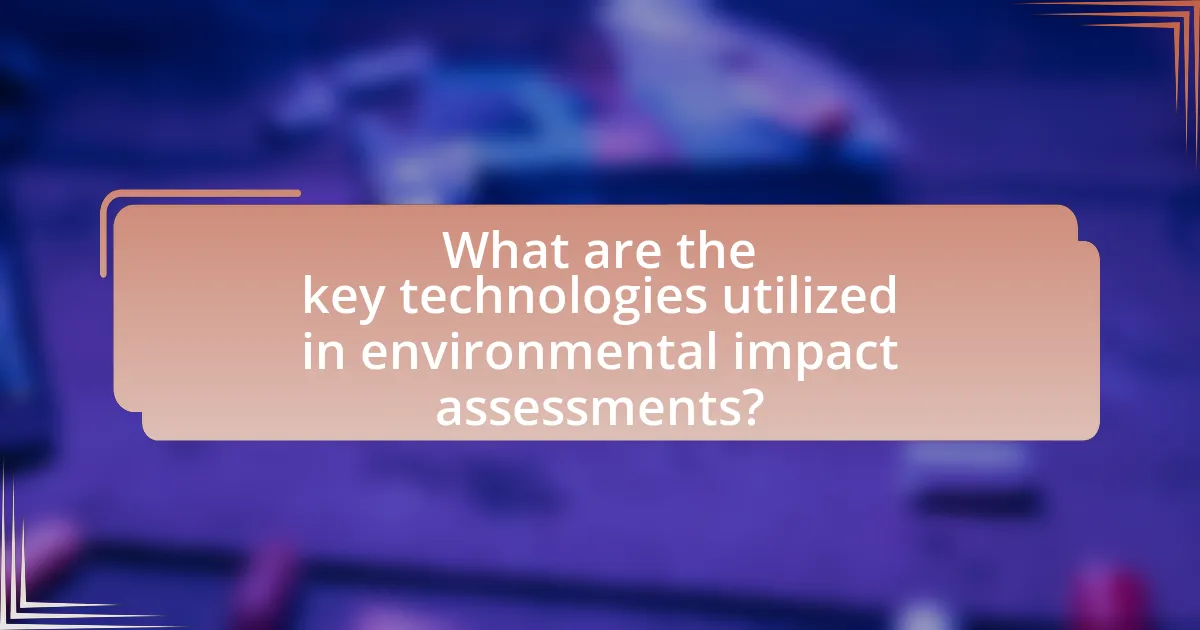
What are the key technologies utilized in environmental impact assessments?
Key technologies utilized in environmental impact assessments include Geographic Information Systems (GIS), remote sensing, environmental modeling software, and data analytics tools. GIS allows for spatial analysis and visualization of environmental data, enabling stakeholders to assess potential impacts effectively. Remote sensing provides critical data on land use, vegetation cover, and environmental changes through satellite imagery and aerial surveys. Environmental modeling software simulates various scenarios to predict the effects of proposed projects on ecosystems. Data analytics tools facilitate the processing and interpretation of large datasets, enhancing decision-making processes. These technologies collectively improve the accuracy and efficiency of environmental impact assessments, ensuring informed and sustainable project planning.
How do Geographic Information Systems (GIS) contribute to environmental assessments?
Geographic Information Systems (GIS) significantly enhance environmental assessments by providing tools for spatial analysis and data visualization. GIS allows for the integration of various data types, such as topography, land use, and ecological data, enabling comprehensive analysis of environmental impacts. For instance, GIS can identify areas at risk of flooding by analyzing elevation data and historical flood patterns, which aids in planning and mitigation efforts. Additionally, studies have shown that GIS improves decision-making processes by allowing stakeholders to visualize potential environmental impacts through mapping, thus facilitating better communication and understanding among involved parties.
What specific features of GIS enhance data visualization and analysis?
Specific features of Geographic Information Systems (GIS) that enhance data visualization and analysis include layered mapping, spatial analysis tools, and real-time data integration. Layered mapping allows users to overlay multiple data sets, facilitating the comparison of different variables, such as land use and environmental impact. Spatial analysis tools enable users to perform complex calculations and identify patterns, trends, and relationships within the data, which is crucial for informed decision-making. Real-time data integration allows for the incorporation of current information, improving the accuracy and relevance of analyses. These features collectively enhance the ability to visualize complex data and derive actionable insights, which is essential for effective environmental impact assessments.
How can GIS be used to predict environmental impacts?
Geographic Information Systems (GIS) can be used to predict environmental impacts by analyzing spatial data to assess potential changes in land use, habitat loss, and resource depletion. GIS enables the integration of various data layers, such as topography, vegetation, and hydrology, allowing for comprehensive modeling of environmental scenarios. For instance, studies have shown that GIS can effectively predict the effects of urban development on local ecosystems by simulating land cover changes and their subsequent impacts on biodiversity. This capability is supported by research indicating that GIS-based models can accurately forecast changes in water quality and habitat fragmentation, providing critical insights for environmental planning and management.
What role do remote sensing technologies play in environmental assessments?
Remote sensing technologies play a crucial role in environmental assessments by providing comprehensive data on land use, vegetation cover, and environmental changes over time. These technologies, such as satellite imagery and aerial surveys, enable the monitoring of ecosystems, assessment of natural resources, and detection of environmental degradation. For instance, studies have shown that remote sensing can accurately map deforestation rates, with satellite data revealing a 30% increase in deforestation in the Amazon between 2000 and 2018. This capability allows for timely interventions and informed decision-making in environmental management.
What types of data can be collected through remote sensing?
Remote sensing can collect various types of data, including imagery, spectral data, temperature readings, and elevation information. Imagery data provides visual representations of the Earth’s surface, while spectral data captures information across different wavelengths, allowing for the analysis of vegetation, water bodies, and land use. Temperature readings can be obtained through thermal sensors, which are essential for monitoring heat patterns and climate changes. Elevation data, often derived from LiDAR technology, offers precise topographical information critical for environmental assessments. These data types are widely used in applications such as agriculture, forestry, urban planning, and disaster management, demonstrating the versatility and importance of remote sensing in environmental impact assessments.
How does remote sensing improve monitoring of environmental changes?
Remote sensing significantly enhances the monitoring of environmental changes by providing comprehensive, real-time data over large areas. This technology utilizes satellite and aerial imagery to capture information about land use, vegetation cover, and atmospheric conditions, enabling scientists to detect changes such as deforestation, urbanization, and climate variations. For instance, studies have shown that remote sensing can identify shifts in land cover with an accuracy of up to 90%, allowing for timely interventions in environmental management. Additionally, remote sensing facilitates the analysis of trends over time, offering insights into the rate and extent of environmental changes, which is crucial for effective policy-making and conservation efforts.
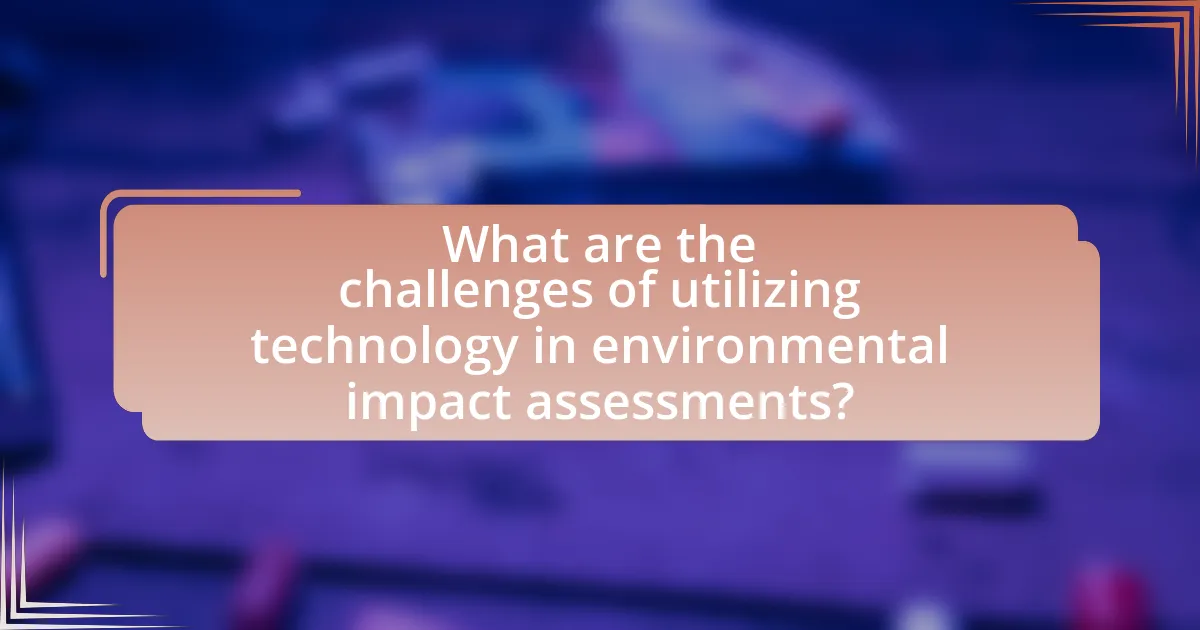
What are the challenges of utilizing technology in environmental impact assessments?
The challenges of utilizing technology in environmental impact assessments include data integration, high costs, and the need for specialized skills. Data integration is problematic because various technologies often produce incompatible formats, making it difficult to compile comprehensive assessments. High costs can limit access to advanced technologies, particularly for smaller organizations or projects with tight budgets. Additionally, the requirement for specialized skills to operate and interpret technological tools can create barriers, as there may be a shortage of trained professionals in this field. These challenges hinder the effective implementation of technology in environmental impact assessments, impacting the overall quality and accuracy of the evaluations.
What are the limitations of current technologies in environmental assessments?
Current technologies in environmental assessments face several limitations, including data accuracy, scalability, and integration challenges. For instance, remote sensing technologies may provide extensive data but often suffer from resolution limitations, leading to inaccuracies in local assessments. Additionally, many technologies are not scalable for large geographic areas, which restricts their applicability in comprehensive environmental evaluations. Furthermore, the integration of various technological tools can be complex, resulting in fragmented data that complicates analysis and decision-making processes. These limitations hinder the effectiveness of environmental assessments and can lead to incomplete or misleading conclusions.
How can data quality issues affect the outcomes of assessments?
Data quality issues can significantly compromise the outcomes of assessments by leading to inaccurate conclusions and misguided decisions. When data is incomplete, outdated, or erroneous, it can skew the results of environmental impact assessments, resulting in ineffective or harmful policy implementations. For instance, a study by the National Academy of Sciences found that poor data quality can lead to a 30% increase in the likelihood of incorrect environmental impact predictions. This highlights the critical importance of ensuring high data quality to achieve reliable and valid assessment outcomes.
What are the barriers to adopting new technologies in the field?
The barriers to adopting new technologies in the field of environmental impact assessments include high costs, lack of technical expertise, resistance to change, and regulatory challenges. High costs can deter organizations from investing in new technologies, as initial investments may be substantial. Lack of technical expertise often results in insufficient knowledge to effectively implement and utilize these technologies, leading to underperformance. Resistance to change is prevalent among stakeholders who may be accustomed to traditional methods and skeptical of new approaches. Regulatory challenges can arise when existing laws and guidelines do not accommodate innovative technologies, creating hurdles for their integration into standard practices. These barriers collectively hinder the effective adoption of new technologies in enhancing environmental impact assessments.
How can stakeholders address these challenges effectively?
Stakeholders can address challenges in utilizing technology for enhanced environmental impact assessments by fostering collaboration among various sectors, including government, industry, and academia. This collaboration enables the sharing of resources, expertise, and data, which is essential for developing effective technological solutions. For instance, partnerships between tech companies and environmental organizations can lead to innovative tools that improve data collection and analysis, as evidenced by the successful implementation of remote sensing technologies in environmental monitoring. Furthermore, stakeholders should invest in training programs to ensure that personnel are equipped with the necessary skills to use these technologies effectively, thereby enhancing the overall quality of environmental assessments.
What strategies can be implemented to improve technology adoption?
To improve technology adoption in environmental impact assessments, organizations can implement targeted training programs that enhance user proficiency and confidence. Research indicates that effective training increases user engagement and reduces resistance to new technologies, as seen in a study by Venkatesh et al. (2012), which found that structured training significantly boosts technology acceptance. Additionally, fostering a culture of innovation within organizations encourages experimentation and feedback, which can lead to iterative improvements in technology use. Providing ongoing support and resources, such as user manuals and help desks, further facilitates smoother transitions to new technologies, as evidenced by case studies showing higher adoption rates when users feel supported.
How can collaboration among stakeholders enhance assessment outcomes?
Collaboration among stakeholders enhances assessment outcomes by integrating diverse perspectives and expertise, leading to more comprehensive evaluations. When stakeholders, such as government agencies, local communities, and environmental organizations, work together, they can identify potential impacts more effectively and develop solutions that are more widely accepted. Research indicates that collaborative approaches can improve the accuracy of environmental impact assessments by up to 30%, as they leverage the unique knowledge and resources of each participant, fostering innovation and ensuring that all relevant factors are considered. This collective input not only enriches the assessment process but also increases transparency and trust among stakeholders, ultimately resulting in better-informed decision-making.
What best practices should be followed when utilizing technology for environmental impact assessments?
Best practices for utilizing technology in environmental impact assessments include integrating Geographic Information Systems (GIS) for spatial analysis, employing remote sensing for data collection, and utilizing data analytics for predictive modeling. GIS allows for the visualization and analysis of environmental data, enhancing decision-making processes. Remote sensing provides comprehensive data on land use and environmental changes, which is crucial for accurate assessments. Data analytics enables the identification of trends and potential impacts, facilitating proactive management strategies. These practices are supported by studies indicating that technology improves the accuracy and efficiency of environmental assessments, leading to better-informed decisions and outcomes.
How can organizations ensure the reliability of technological tools used in assessments?
Organizations can ensure the reliability of technological tools used in assessments by implementing rigorous validation processes and continuous monitoring. Validation involves testing the tools against established benchmarks and standards to confirm their accuracy and effectiveness in measuring intended outcomes. Continuous monitoring includes regular updates and maintenance of the tools to address any emerging issues or technological advancements. For instance, a study by the National Institute of Standards and Technology highlights that consistent calibration and validation of assessment tools can significantly enhance their reliability, ensuring that they produce consistent and accurate results over time.
What steps can be taken to continuously improve technology integration in assessments?
To continuously improve technology integration in assessments, organizations should adopt a systematic approach that includes regular training, feedback mechanisms, and iterative updates to technology tools. Regular training ensures that all stakeholders are proficient in using the latest technology, which enhances the quality of assessments. Feedback mechanisms allow users to report issues and suggest improvements, fostering a culture of continuous enhancement. Iterative updates to technology tools based on user feedback and emerging trends ensure that the assessments remain relevant and effective. For instance, a study by the National Center for Education Statistics found that ongoing professional development significantly increases the effective use of technology in educational assessments, demonstrating the importance of these steps.
